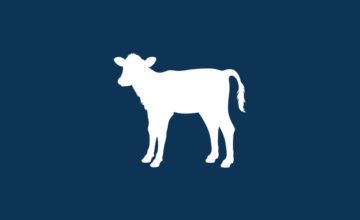Ewe Nutrition & Its Effect on Lamb Growth
- Mar 16, 2009
- By Grober Nutrition
- In Canada, USA
- In the pre-lambing season it is worthwhile remembering the nutrition requirements of the ewe and the impact it can have on lamb viability and growth. Ewe nutrition needs increase significantly and accelerate rapidly, in the 4-6 weeks before lambing.
- This is to support the rapidly growing fetus and encourage proper udder development for colostrum and milk production.
- 70% of lamb fetal growth occurs in the last 6 weeks, during which time rumen capacity and food intake are decreasing.
- If nutrient demands of the ewe are not met, not only can pregnancy toxemia/ twin lamb disease occur but also lamb growth and survival will be compromised. Ensure adequate nutrient intake for strong, vigorous lambs of moderate birth-weight.
Why is it important?
1. Reduced fetal growth in pre-lambing period results in lower birth weight lambs:
- Average daily gain tends to be greater in higher birth-weight lambs when provided ad-libitum access to feed- (Greenwood et al, J.Ani Sci 1998)
- Low birth-weight newborns tend to have poor energy utilization and can have more fat than larger lambs.
- Low birth-weight lambs have less resistance to cold, so they are at greater risk of hypothermia (a combination of chilling and starvation)
2. Poor ewe nutrition may result in reduced brown fat reserves in the lamb:
- Brown fat and colostrum help the newborn lamb maintain heat.
3. Poor ewe condition (underfeeding) reduces colostrum and milk production:
- Insufficient quality and quantity of colostrum and milk will put lamb at risk for hypothermia and disease.
4. Poor ewe nutrition can reduce mineral and vitamin levels in the lamb: Examples of mineral and vitamin deficiency consequences:
- Selenium (Se): Newborn lambs born are susceptible to white muscle disease, ‘stiff lamb disease’, from birth to 3 weeks old. Low Se affects response to hypothermia, as it is a component of the mechanism that releases heat from brown adipose tissue. Dietary Se levels are reflected in colostrum, milk and lamb plasma levels (placental transfer).
- Vitamin E: is unable to cross the placental barrier and so the newborn is reliant on levels from ewe milk, milk replacer or injection. Dietary vitamin E levels are reflected in colostrum and milk but can be variable. Vitamin E and Se have a sparing effect on each other and are important in disease resistance.
- Iodine (I): Results in goiter (enlarged thyroid gland), stillborn lambs with very little wool or lambs have low viability. Iodine freely passes the placental barrier.
- Cobalt (Co): impairs milk production and lambs from these ewes tend to have less vigor, be slower to stand and start suckling.
- Copper (Cu): Lambs from low copper status ewes are more susceptible to ‘swayback’, muscular incoordination, partial paralysis of the hind quarters. Lambs are born weak and may die form inability to nurse. Can show in newborns or can be delayed for weeks or months.
- Manganese (Mn): newborn lambs lack coordination from bone abnormalities
- Vitamin A: (winter feeding with little green forage) – lambs are weak, malformed or dead and have night blindness.
Ewe preparation advice:
- Observe lambing dates. The ewe’s gestation period is from 144 to 151 days, with an average of 147 days.
- Observe ewe body condition. The ideal body condition score, 8 weeks before lambing, is 2.5-3.5 (lowland ewes), 2-3 (hill/upland ewes).
- Ultrasound scanning for number of fetuses, between 50 -90 days of pregnancy, helps group ewes and feed accordingly.
- Analyze forage quality so that a ration can be formulated for optimum performance. Feed good quality forage to maximize food intake.
- Match feed supply to requirements of ewe and number of fetuses from 6 weeks pre-lambing. Feed requirements for energy, protein, minerals and vitamins will depend on forage quality, availability and environmental conditions.
- Feeding a high-energy supplement helps counter reduced rumen capacity and food intake.
- Cold temperatures will increase energy requirements.
- Fetal growth accelerates rapidly during late gestation. Energy required is much higher for the two weeks pre-lambing versus six weeks pre-lambing.
- Have lambing equipment ready, including clean feeding bottles, teats and high quality milk or milk replacer.
Tags: Lamb
Grober Nutrition
Recent Posts
Tags
Archives
- October 2024
- July 2024
- May 2024
- April 2024
- January 2024
- December 2023
- October 2023
- September 2023
- August 2023
- June 2023
- December 2022
- November 2022
- October 2022
- August 2022
- July 2022
- June 2022
- May 2022
- April 2022
- March 2022
- February 2022
- January 2022
- August 2021
- February 2021
- September 2020
- June 2020
- April 2020
- May 2017
- April 2017
- October 2016
- September 2016
- August 2016
- March 2016
- March 2015
- January 2015
- December 2014
- December 2013
- September 2013
- May 2013
- January 2013
- December 2012
- November 2012
- March 2012
- March 2011
- February 2011
- November 2010
- August 2010
- December 2009
- November 2009
- March 2009















